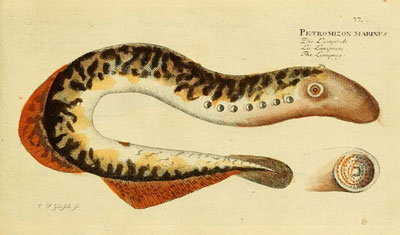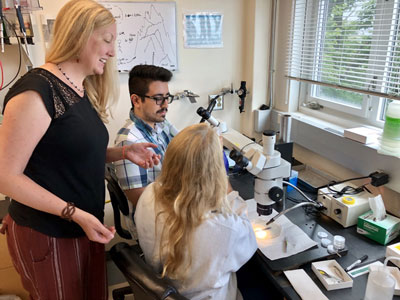Seeing through Synapses: Jennifer Morgan’s Mission in Science and Service


Jennifer Morgan sat comfortably at the desk in her spacious office, slices of sun and sea peeking through the half-closed blinds. A personalized, ceramic representation of Morgan’s research animal, the lamprey, hung near the window. A slender and eel-like jawless fish, it’s displayed on her wall coiled up, the mouth, teeth, eyes, and gills evident. The lamprey’s coiled body creates the shape of a heart and the letter J at the same time.
“Lori Horb, who works in the Bell Center, made this for me,” Morgan smiled warmly. “One of the postdoctoral scientists in my lab designed it and Lori made it.” The gifted piece of art is only the beginning of the testament to Morgan’s embodiment of collaborative science and service to young scientists.
Morgan is director of the MBL’s Eugene Bell Center for Regenerative Biology and Tissue Engineering, where she oversees 12 principal investigators and more than 40 postdoctoral scientists and research staff members. As director, Morgan works hard to support and guide the faculty to success. “For me it’s a service role, and it’s for the benefit of the Bell Center and the MBL at large,” Morgan said.
In addition, Morgan conducts her own neurobiological research and supports a research team of five to 10 people. Her team uses an eel-like fish, the lamprey, to study the intricate workings of the nervous system, specifically neurodegenerative disorders and recovery from spinal cord injury.
The lamprey’s large neurons allow for easy access and imaging, providing a huge advantage for neuroscience researchers. Even more advantageous, the molecules, gene structures, and proteins linked to disease processes that can be found in the lamprey are similar to those seen in humans. The lamprey allows for a level of experimental accessibility that’s helpful for exploring fundamental biological processes, Morgan finds. “[We can] learn something about how the neurons work, how the proteins work, in this idealized system and then you can take the key findings and then see if it holds up in a mammalian nervous system,” she said.
Labib Rouhana, a colleague in the field of regenerative biology and a former student of Morgan’s in the Stem Cells and Regeneration Course (SCaRE) at MBL, described Morgan’s mentorship style as “one based on empowerment and inspiration.” Now an associate professor of biological sciences at Wright State University, Rouhana does his best to follow Morgan’s lead as a mentor, fostering a similar style of guiding scientists during the early stages of their careers.
Though science can be a lonely enterprise, Rouhana said, Morgan’s investment in collaboration and service has created a different community. “Over the years I have come to realize that what her and co-organizers are building is a community of mentors, mentees, and colleagues with diverse scientific interest but with the common interest of helping each other succeed,” Rouhana said.
 Morgan's research organism, the lamprey, can regenerate its spinal cord and resume swimming within 12 weeks of injury. Credit: Biodiversity Heritage Library
Morgan's research organism, the lamprey, can regenerate its spinal cord and resume swimming within 12 weeks of injury. Credit: Biodiversity Heritage LibraryMorgan’s desire to give back to the scientific community at MBL stems from her deep-rooted history with the lab. “I’ve been affiliated with the MBL in one way, shape, or form literally through my entire academic career, starting when I was an undergraduate,” she said. “I’ve always found the MBL to be a place where I can be very collaborative, very creative.”
A life in science
Morgan first began getting her toes wet with science as a child, identifying local species of plants, birds, and animals in her backyard. She grew up with a science-minded father who was inquisitive and encouraging. By the time she began college at the University of North Carolina at Chapel Hill, she was decidedly a scientist and landed on biology as a major. Not long after, Morgan began working in a lab focused on how neurons communicate with each other. Her career as a young intellectual quickly took shape as immersive research opportunities appeared on her horizon. “I got very excited about neuroscience from my very first laboratory experience,” Morgan said. “And part of that early on was an opportunity to come to the MBL as an undergraduate to do my summer research.”
After completing her undergraduate degree in biology, Morgan then pursued a Ph.D. in neurobiology at Duke University. She continued to work with MBL in the summers to conduct her primary research, then returned to Duke in the fall to analyze and write up the data. As she continued along her career path, Morgan’s relationship with MBL continued to grow, proving to be a thread throughout her academic and scientific career. “Before I had my full-time position at MBL, I already had 15 summers in Woods Hole under my belt,” Morgan shared. “And now this will be my 24th year.”
Morgan’s research focuses on the cross-talk between nervous system cells. The key players in this process are first and foremost neurons, the cells in our nervous system that allow for the communication of electrical and chemical signals and by proxy, all essential functions of the human body. Then there’s the synapse, the structure that permits the passing of a signal between two neurons. If neurons are cells that can talk to one another, the synapse is host of all their meet-ups. When these interactions occur, neurotransmitter molecules are released. The neurotransmitters carry the actual message that’s being sent between neurons. So as one neuron releases these transmitters, they diffuse across a small space and bind to specialized receptors on the other neuron. Signal received.
 Jennifer Morgan talks with MBL research assistants Kaitlyn Fouke and Eduardo Guadarrama. Photo: Hannah Knighton
Jennifer Morgan talks with MBL research assistants Kaitlyn Fouke and Eduardo Guadarrama. Photo: Hannah Knighton“This talking back and forth between neurons is, in my mind, one of the fundamental processes of how the nervous system works,” Morgan said. Her research focuses on how neurotransmitter stores are maintained at the synapses. “The really critical thing is; how do those synapses maintain their stores of neurotransmitters in their vesicles?”
Morgan’s investigations added an understanding of some of the molecular mechanisms of a rather simple process of recycling neurotransmitter-filled vesicles at the synapses, known as endocytosis. Morgan finds it amazing that endocytosis occurs at the synapses, since most synapses are located at the far end of axons – neural fibers that can be quite long.
“You have one neuron in your hindbrain that extends a single axon all the way down to your big toe,” Morgan said, excitedly describing the extent of the process. “So for your big toe to move and feel, that [neurotransmission signal needs to travel about] two meters.” Morgan’s pointed finger traveled the length down her body as she spoke. “If you had to wait for the neurotransmitters to be trafficked all the way down your body to your big toe … that’s too slow.”
Morgan snapped her fingers in rapid succession. “The nervous system has to be fast,” she said. Snap. Snap. Snap. “It’s working on a millisecond time scale.” This process has proven to be critical, and not just so that we can move our big toes. Vesicle recycling is a highly energetic process that is an early target in neurodegenerative disease processes. As diseases develop, the process tends to be less precise. Morgan’s lab is continuing to explore how vesicle recycling is affected by diseases such as Parkinson’s and Alzheimer’s.
Recently, Morgan’s lab identified a protein linked to familial Parkinson’s disease that is a potential target for understanding and treating spinal cord injury. This protein, alpha synuclein, disrupts the process of neurotransmitter recycling at synapses when it accumulates in large quantities. In her research with lamprey, Morgan found that spinal cord injury induces the accumulation of alpha synuclein, which ultimately leads to neuron death. Since neurons can’t self-repair, this means permanent damage for the nervous system. Morgan’s lab was the first to identify and publish on this. Soon after, another group published supporting evidence after looking at alpha synuclein in the mammalian nervous system.
With about 17,000 new cases of spinal cord injury a year in the United States, this discovery has had large implications for recovery methods. As it stands, spinal cord injury patients rely on physical therapy since there are no FDA-approved drugs that modify neurological recovery. Morgan believes the spinal cord injury field is responsible for building the tool kit to treat patients, and “That tool kit must include drugs.” After their initial findings about alpha synuclein, Morgan went on to apply that new knowledge to drug discovery. After piloting some test drugs, she’s currently applying for a patent for a small molecule drug that could be developed to treat spinal cord injury or neurological disease. “The fact that we’ve identified a target for drug therapy to improve the surviving neurons, improve their growth ability [using the lamprey model] … that’s one of the things I’m proudest of,” Morgan shared.
A generous, thorough collaborator
“Morgan’s approach to answering scientific questions is systematic, creative, and rigorous,” said Ona Bloom. Bloom, currently the inaugural director of the Lab of Spinal Cord Injury (SCI) research and associate professor at the Feinstein Institutes for Medical Research in Manhasset, NY, first met Morgan when they were both postdoctoral fellows in the Department of Cell Biology at Yale School of Medicine. She described Morgan as a generous and thorough collaborator, someone with whom she could spend hours discussing plans and ideas for scientific research. “I have deeply enjoyed and in fact, relied, on discussing science with Dr. Morgan since 2003 and I look forward to doing so for many years ahead,” she said. This is the type of lasting impression that Morgan tends to leave on colleagues and mentees alike.
Alongside the ceramic lamprey, other art hangs in Morgan’s office. On a rectangular painting behind her desk, pink, purple, and silver strokes criss-cross their way across a black background. “That was from a former student of mine. She worked on spinal cord regeneration and this is a representation of one of her images [of a regenerated spinal cord],” Morgan said. It’s yet another testament to her impact as a mentor.
Morgan is caring and efficient, making advances in her own research while still carving out time to support her research team and the Bell Center faculty at large. “I think one of my major roles as the Bell Center director is to do everything I can to support the junior faculty who are just getting started. That’s really essential,” she said. With her genuine dedication to the growth of the scientific community, Morgan hopes to continually encourage young minds, as the mentors of MBL’ s history have done for her.